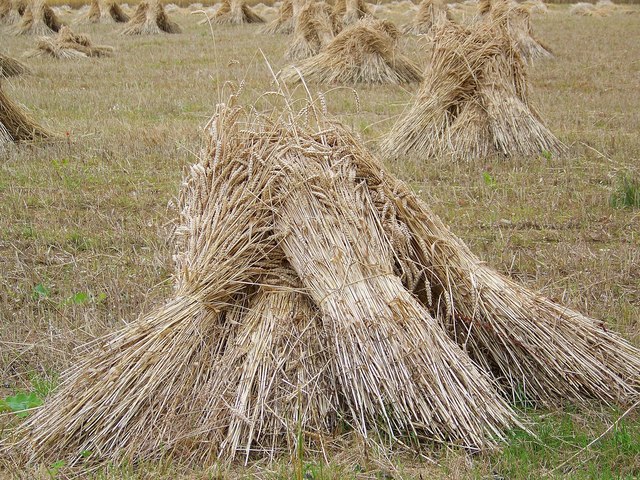Sheaf (agriculture) on:
[Wikipedia]
[Google]
[Amazon]


 A sheaf (/ʃiːf/) is a bunch of cereal-crop stems bound together after reaping, traditionally by
A sheaf (/ʃiːf/) is a bunch of cereal-crop stems bound together after reaping, traditionally by
 In
In

 A sheaf (/ʃiːf/) is a bunch of cereal-crop stems bound together after reaping, traditionally by
A sheaf (/ʃiːf/) is a bunch of cereal-crop stems bound together after reaping, traditionally by sickle
A sickle, bagging hook, reaping-hook or grasshook is a single-handed agricultural tool designed with variously curved blades and typically used for harvesting, or reaping, grain crops or cutting succulent forage chiefly for feeding livestock, ...
, later by scythe
A scythe ( ) is an agricultural hand tool for mowing grass or harvesting crops. It is historically used to cut down or reap edible grains, before the process of threshing. The scythe has been largely replaced by horse-drawn and then tr ...
or, after its introduction in 1872, by a mechanical reaper-binder.
Traditional hand-reapers, using scythes and working as a team, cut a field of grain clockwise, starting from an outside edge and finishing in the middle. Scything leaves a windrow
A windrow is a row of cut (mown) hay or small grain crop. It is allowed to dry before being baled, combined, or rolled. For hay, the windrow is often formed by a hay rake, which rakes hay that has been cut by a mowing machine or by scythe int ...
of cut stems to the left of the reaper and, if cut skillfully, leaves the seed heads more or less aligned. These are then picked up and tied into sheaves by the sheavers, who traditionally use other cut stems as ties. These sheavers, or a following team, then stand the sheaves up in stooks to dry. Three to eight sheaves make up each stook, which forms a self-supporting A-frame with the grain-heads meeting at the top. This keeps the grain well ventilated, and off the ground allowing it to dry and discouraging vermin.
The drying sheaves are later either placed by hand or pitched onto a cart. The traditional sheaf pitchfork
A pitchfork (also a hay fork) is an agricultural tool with a long handle and two to five tines used to lift and pitch or throw loose material, such as hay, straw, manure, or leaves.
The term is also applied colloquially, but inaccurately, to ...
has a long wooden handle, two short tynes and a rounded back to make the placing of sheaves easy. The gathered sheaves are then either built into stacks (thatched stacks could be over 20' high Haystacks (Monet series)) or taken to a barn for further drying before being threshed to separate the grain from the stems.
The mechanisation of agriculture
Mechanised agriculture or agricultural mechanization is the use of machinery and equipment, ranging from simple and basic hand tools to more sophisticated, motorized equipment and machinery, to perform agricultural operations. In modern times, po ...
in industrialised countries, in particular the introduction of the combine harvester
The modern combine harvester, or simply combine, is a versatile machine designed to efficiently harvest a variety of grain crops. The name derives from its combining four separate harvesting operations— reaping, threshing, gathering, and win ...
from the middle of the 19th century, has made the sheaf redundant, but sheaves remain in widespread use wherever harvesting is still done by hand or by reaper-binder.
Heraldry
heraldry
Heraldry is a discipline relating to the design, display and study of armorial bearings (known as armory), as well as related disciplines, such as vexillology, together with the study of ceremony, rank and pedigree. Armory, the best-known bran ...
a wheat sheaf is called a garb.
See also
* Omer (unit), a Biblical measure of volume of grain.References
External links
* Commons category Garbs * Commons category Garbs in heraldry Agricultural terminology Heraldic charges {{heraldry-stub